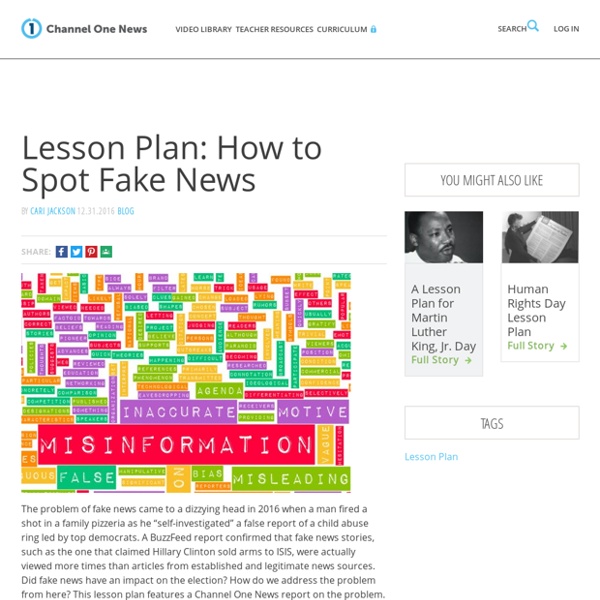Zoom
Trash



https://www.channelone.com/blog_post/lesson-plan-how-to-spot-fake-news/
Related: AXE 4 - citoyenneté et mondes virtuels • COLLECTION: Media Literacy and Fake News • COLLECTION: Infographics • Fake News • Truth or FictionGood Tools for Teaching Students How to Evaluate Web Content Credibility Source: Butler University Library, adapted from Meriam Library at CSU, Chico One of my favorite lessons to teach is about evaluating the credibility of web sites and other digital content. I often start by showing the classic “Can't Lie On The Internet” video from AllState, which gets a laugh and helps to get students in the right mind set. Next, we check out the classic “DHMO” site and talk about what we see there. Dihydrogen Monoxide sounds pretty scary, but is this site legitimate?
Book Trailers and the Common Core Standards --------- Students use technology & digital media strategically and capably.-- Common Core Standards. The Honest Truth about Fake News … and How Not to Fall for It (with Lesson Plan) Did you hear that Pope Francis endorsed Donald Trump for president? Or that Hillary Clinton sold weapons to ISIS? Crazy, right? And … 100 percent false. How to outsmart fake news in your Facebook feed It doesn't have to be this way. Fake news is actually really easy to spot -- if you know how. Consider this your New Media Literacy Guide. 1. Does the story come from a strange URL? Zimdars says sites with strange suffixes like ".co" or ".su," or that are hosted by third party platforms like WordPress should raise a red flag.
Search, fake news and politics - an international study How are people using search, social media and other forms of media to get information about politics, politicians and political issues? Are we right to be worried about the impact search algorithms have on shaping political opinions or about inaccurate, false and politically biased information that distorts public opinion? A study, conducted jointly by researchers from the Oxford Internet Institute (University of Oxford) and the Quello Center (Michigan State University) questioned 14,000 internet users from France, Germany, Italy, Poland, Spain, the UK and the USA about how they used traditional and online media. Search performance has the potential to support or undermine democratic processes. Does search enable citizens to obtain better information about candidates and political issues or does search bias distort search results? The research set out to go beyond anecdote.
Post-Truth and Fake News Earlier in the year I was tasked with creating a resource guide on “post-truth” and fake news. It’s not something I was clamoring to do. To be honest: I was still in the post-election malaise–and my heart was just not into it. Rarely would I label any of my work tasks as “edicts,” (I like the flexibility and creativity of my job) but this time it was.
10 Assessments You Can Perform in 90 Seconds 10 Assessments You Can Perform In 90 Seconds by TeachThought Staff Good assessment is frequent assessment. Any assessment is designed to provide a snapshot of student understand—the more snapshots, the more complete the full picture of knowledge. On its best day, an assessment will be 100% effective, telling you exactly what a student understands. More commonly, the return will be significantly lower as the wording of questions, the student’s sense of self-efficacy, or other factors diminish their assessment performance. Video and a related lesson plan from TEDEd. Update: Please also see our new, 2017 lesson, Evaluating Sources in a ‘Post-Truth’ World: Ideas for Teaching and Learning About Fake News _________ How do you know if something you read is true?